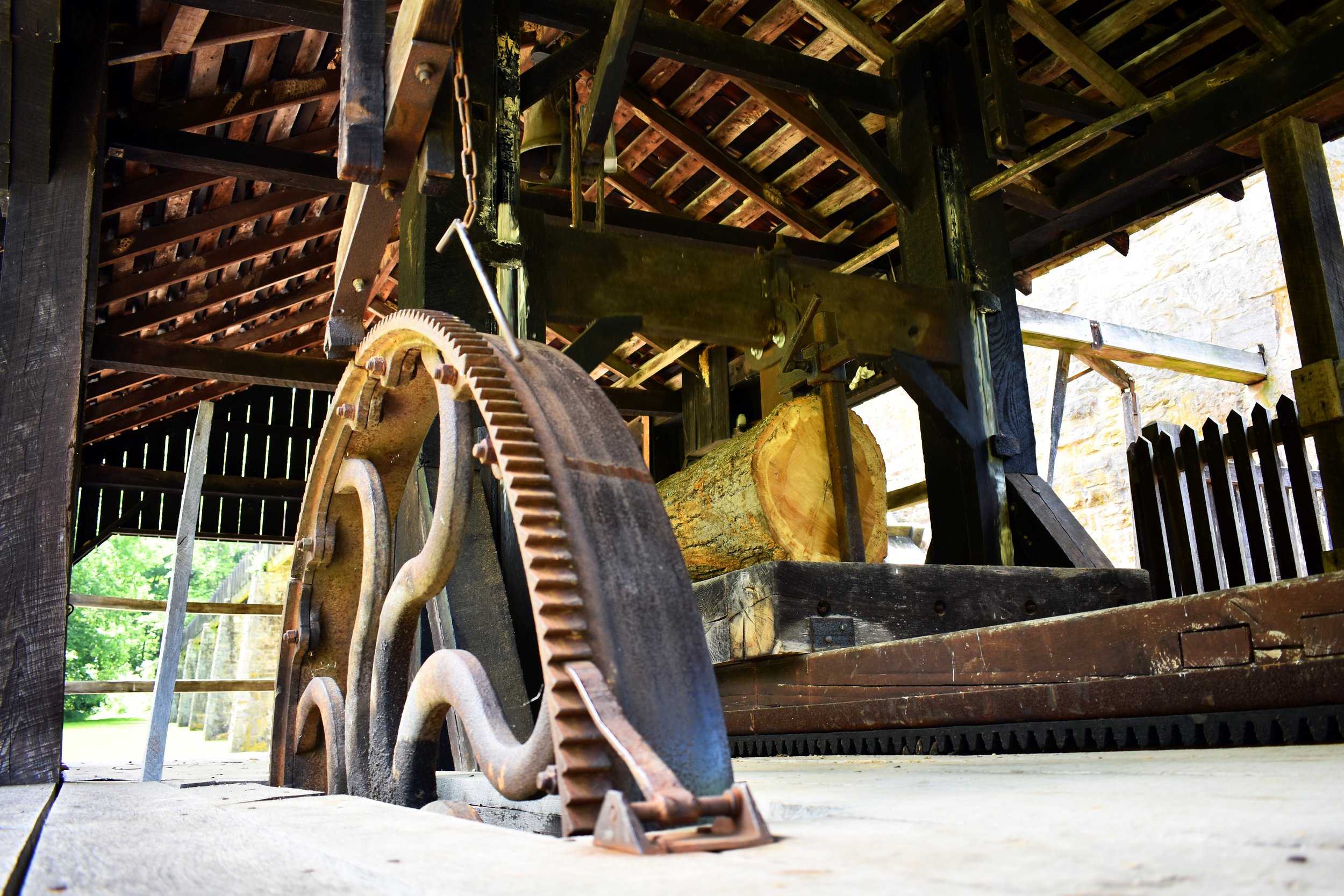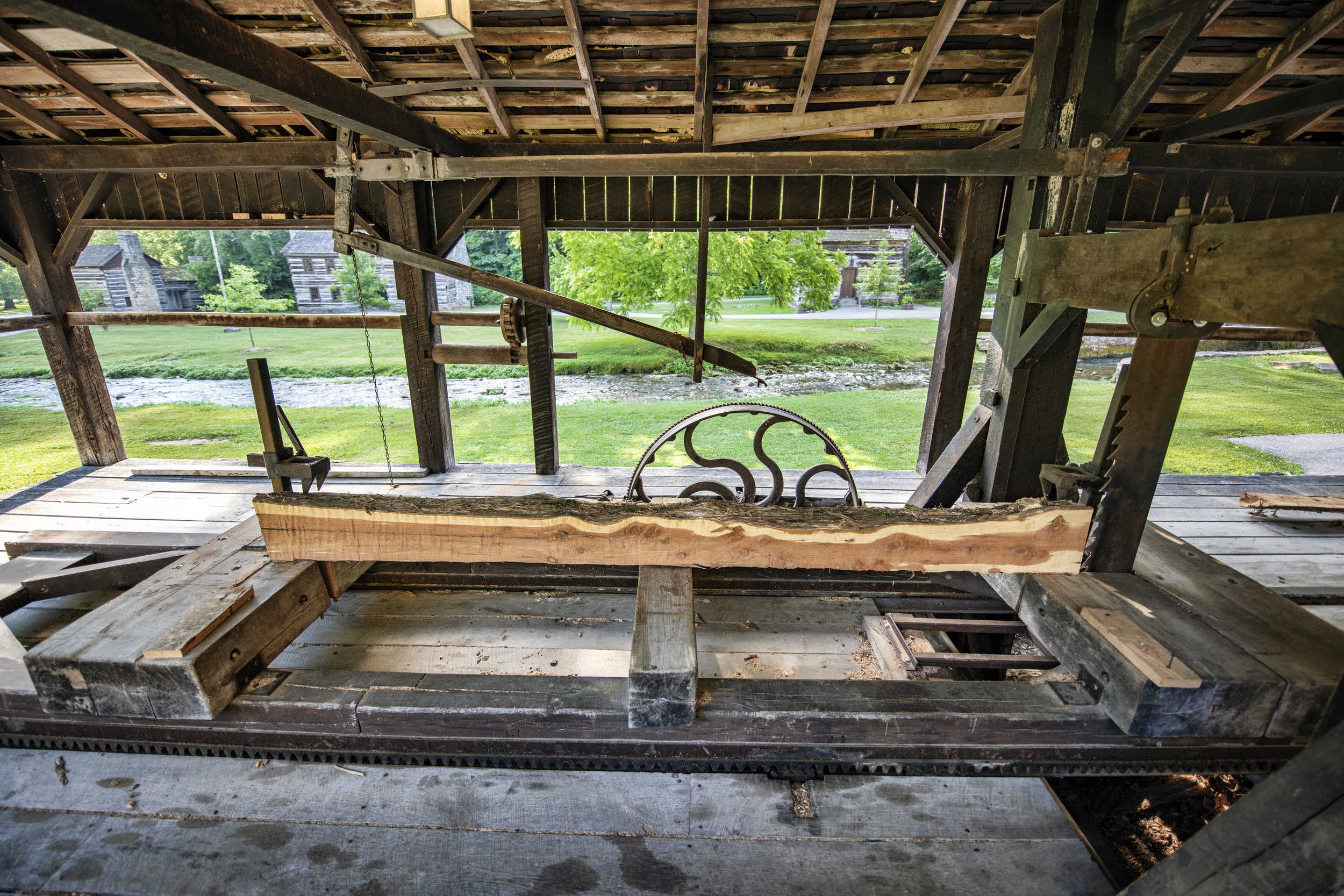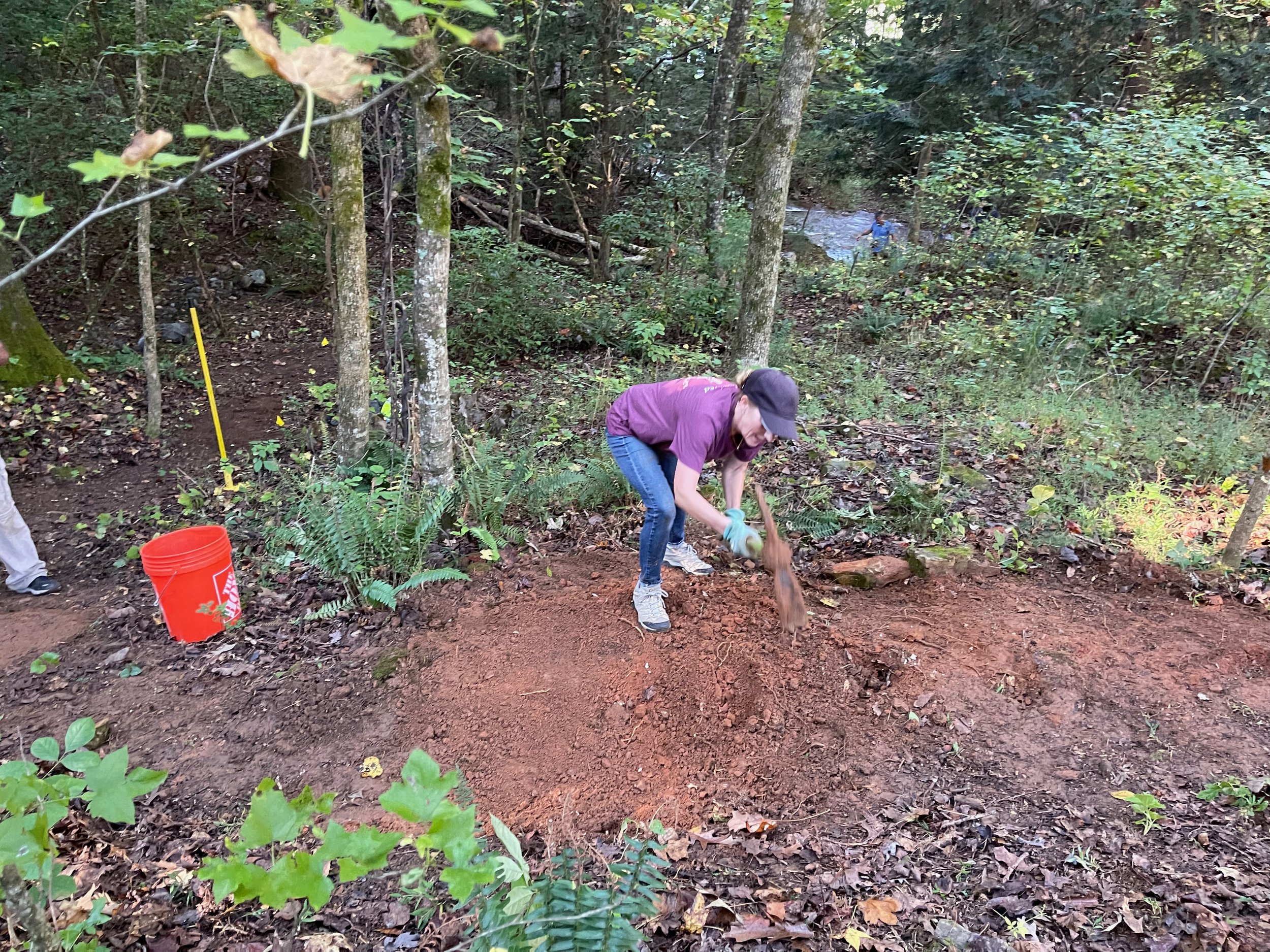The ruins at Choctaw
The newly cleaned up pillars that were the foundation of the Weaver mill, built in the early 1840s. Photo by Liz Scherer
Several months ago, trails committee member Mitch Waldman noticed some stone pillars by the stream while walking his dogs on the Choctaw trail. He went to investigate and thought they may be part of an old bridge foundation, but there were no corresponding pillars on the other side of the creek. He asked me about them but I didn’t know what they were. We’re familiar with the stone pillars that supported a bridge on both sides of the creek on John Williams trail and Covered Bridge trail, but these were new to us. Intrigued, we started searching the Smoke Signals online archives and we found a series of articles by historian Charlene Terrell on the history of the Wolfscratch area.
Gristmills were typically supported by the local farmers in 19th century rural communities. Farmers would bring their own grain to be milled into grits or flour (called meal). The miller would keep a share of the final product as payment, called the “miller’s toil”. Photo credit: Adobe Stock
Millstones such as these were set up horizontally, one on top of the other. The bottom stone was fixed, and the upper one would rotate at over 100rpm. The gap between the stones was carefully monitored to maintain the desired meal fineness while avoiding the stones touching, which would both cause uneven wear and result in gritty flour. Photo credit: Adobe Stock
Turns out the pillars were not the foundation for a bridge, but for a mill house. Here’s the story. In the late 1830s one of the families that moved to Wolfscratch were newly weds Samuel and Harriet Weaver. Samuel, a talented craftsman, built a log cabin for them, followed by a two-story building that housed both a gristmill and a sawmill, powered by a waterwheel. The location is near the current large wooden bridge on Choctaw Pass. The mill house was supported by large stone pillars, some of which you can see still standing next to the stream.
Many daffodils grow on the slope above the mill. It is said they were planted by Harriet, Samuel Weaver’s wife when they built their cabin and mill. The cabin was located on the other side of the Choctaw trail. Photo by Randy Lewis
According to Terrell, “the first dam built for the […] mill was made of hemlock logs”, which would help channel the water to the wheel and thus power the grinding stones or the saw. Later the hemlocks were replaced with a stone wall. However that wall is no longer standing.
After Samuel died, his son Peter continued to operate the saw and grist mill with the help of his children. Peter lived in the cabin his parents lived in with his family. The cabin was later known as the Pete House.
Part of the “Pete House log cabin is now in Big Canoe’s Nature Valley, having been moved and reassembled there in the early 1970s”, Terrell wrote. It is next to the Jeep Trail and is the original portion that Samuel Weaver built. Additions to the cabin were built to accommodate the expanding family, but those were not preserved.
Peter sold the land to Sam Tate in 1908. The stone pillars by the stream are all that remains of the mill today. When Bill Byrne developed the Choctaw Village he added the Choctaw Trail and a small trail down to the ruins, with a beautiful bench overlooking the pillars. However, it was not maintained and quickly got overgrown and forgotten.
The Trails Committee decided to bring this piece of history back into our community’s awareness. On a nice October day, eleven members cleared a path from the Choctaw Trail down to the stream, cutting up downed trees, carving the trail and installing steps where needed. Also they removed the original bench the developer had installed, which was now a heap of rotted wood and installed a new one. They also cleared the vines and vegetation from the pillars and surrounding area, and in doing so, discovered a piece of a gear from the original mill.
The bench installed by the developer when Choctaw was built. This photo was taken in 2008. Photo by Randy Lewis
In the process of cleaning up the ruins. Photo by Liz Scherer
The gear was a very exciting find. Of the team, Don Gallagher, a mechanical engineer, determined that it was a sand-cast gear, and one showing fine craftsmanship. A sign is being made to be installed at the site with a brief description of the ruins, integrating it into the design for all to enjoy.
The ratchet gear found at the ruins site was one of many that would be mounted in a circle onto a large solid wheel forming the ratchet edge to control the direction of the movement. Photo by Mitch Waldman
The Weaver mill saw had a vertical blade, the “up and down” type common of the era. The mechanism, powered by the waterwheel, not only operated the saw blade, but would also advance a log through it, to cut boards, planks and timbers as needed. Photo credit: Adobe Stock
The saw mill would operate an “up and down” saw blade. The wheel would move the blade up and down and also move the log bed forward. Photo Adobe Stock.
Sheila Waldman doing her part in cutting the trail. It’s hard work! Photo by Liz Scherer
After a hard morning’s work, trails committee members have finished the trail. Photo by Liz Scherer
To visit the site, you turn off Wilderness onto Clubhouse Drive and take an immediate right onto Choctaw pass. After you cross the large bridge, take the first left on Isuba Trail, where you can park along the road or at the cul-de-sac, and walk down back toward the bridge. There you will see an entrance to the Choctaw Trail, and after a few yards the new trail will be on your right.
Entrance to the Choctaw trail off of Choctaw Pass. The trail down to the mill ruins is shortly past the entrance, on the right. Photo by Liz Scherer













